When communication in a team is off, every aspect of work takes a hit— from employee happiness and productivity to company success and earnings.
Given that team communication is an integral part of successful good team collaboration, assessing the state of it in your organization and finding ways to improve it is more than worth your time.

- 64% of business leaders believe effective communication has increased their teams’ productivity, and 55% of knowledge workers agree.
- Improving communication can boost overall team happiness — employee happiness is vital for the company’s long-term success and well-being.
- 58% of workers noted that effective communication increased their job satisfaction and confidence at work.
- Organizations whose employees are well-connected show a productivity increase of 25%.
- A proper professional should be polite, but not submissive, and confident, but not too aggressive.
Why is it important to improve team communication?
Great team communication is essential for the success of any organization.
According to Pumble’s Workplace Communication Statistics, 64% of business leaders believe effective communication has increased their teams’ productivity, and 55% of knowledge workers agree.
In addition to these statistics, here are some more compelling reasons you should strive to improve your team communication.
#1 Effective team communication saves money
Companies need to be made aware that the state of communication in their teams has a tremendous impact on their earnings.
According to a report from Axios HQ, ineffective communication takes a serious toll on US business — it amounts to $2 trillion annually.
So, putting some effort into improving communication can save a lot of money in the long run.
🎓 Pumble Pro Tip
To find out more about the importance of improving team communication, check out our guide:
#2 Effective team communication equals higher productivity
According to an older McKinsey work productivity report, organizations whose employees are well-connected show a productivity increase of 20-25%.
A newer study by McKinsey concluded that employees who feel included in workplace communication are around 5 times more likely to report increased productivity.
So, unobstructed information flow is integral for team productivity.
#3 Great team communication is essential for employee retention
Team communication increases employee engagement, which is one of the key aspects of a successful company.
According to Pumble’s statistics on workplace communication, 58% of workers noted that effective communication increased their job satisfaction and confidence at work.
This is essential because having engaged workers reduces turnover by:
- 51% in organizations that have low turnover, and
- 21% in organizations that have high turnover.
Hence, if you want your employees to stay loyal to your company and thrive with it — work on team communication skills.
#4 Great team communication boosts employee happiness
Multiple studies on communication have found that improving communication can boost overall team happiness — and employee happiness is vital for the company’s long-term success and well-being.
Once the employees are more open to communicating with each other, they will learn more about their colleagues.
Hence, the trust between colleagues will increase, and professionals will be happy to work in a more friendly atmosphere.
#5 Open and regular communication improves team motivation
When employees don’t get all the necessary information they need to perform a task and they don’t feel free to ask for it, it’s only natural that they won’t feel motivated to do their jobs.
However, clear communication about the team’s immediate tasks is not the only thing that matters — team members should also get regular updates on company goings-on and plans.
This information helps them see the bigger picture, i.e. how their work contributes to overall company success.
8 Strategies for building and improving team communication
Now that we’ve covered the importance of team communication, it is time to learn more about the most efficient strategies for building and improving your team communication.
We compiled a list of 8 best practical strategies that will help you gradually build and improve communication within your team or organization. Let’s dive in!
#1 Set communication guidelines
First things first — you need to analyze the communication in your workplace and decide where to start. This is the most important and most difficult step in the process.
If communication in your workplace seems chaotic, you will need to analyze it thoroughly and propose concrete processes your team will need to follow.
You should ask yourself questions such as:
- At what point in the communication process do the problems occur?
- Does the main problem lie in the internal or external communication?
- Are there any obvious things that should stop immediately to enable further improvements?
- Is the problem complex? Is the communication problem a matter of disengaged employees?
- Is there a “main issue”? Can it be described through various smaller issues that cause it?
- What is the best way to address the issue or multiple communication issues?
Apart from these questions, numerous others might arise that will be more useful and applicable to your workplace.
After getting initial answers, you will need to address:
- How the communication is handled internally and externally,
- Which communication channels are used in specific situations, and
- The way information is communicated (both verbally and nonverbally via tone of voice, nonverbal cues, etc.) by individual employees or groups.
Depending on the state of the communication in your workplace, you may need to organize education sessions and workshops to completely transform your approach to workplace communication, to tackle the root of the problem.
It will take effort and patience, but with the right plan, your new communication guidelines will bring long-term benefits to everyone open for improvement.
🎓 Pumble Pro Tip
If it’s difficult to get started with communication improvements in your team, you can start by creating a communication plan. Read more about it in the guide below:
For more templates, make sure to check out the following guide:
#2 Analyze and reconcile differing communication styles
Communication problems in the workplace often stem from mismatched communication styles.
Imagine a completely passive communicator trying to resolve a work-related problem with a confrontational person who has a bad temper, or an assertive communicator coming into contact with a sarcastic and passive-aggressive coworker. It’s safe to say that, without mitigation, communication breakdowns would be imminent.
Luckily, you can avoid that by deepening your knowledge of different communication styles and learning how to reconcile them.
5 team communication styles by Edmund J. Bourne
In his book The Anxiety and Phobia Workbook, psychologist Edmund J. Bourne has distinguished 5 different communication styles:
- Submissive,
- Aggressive,
- Passive-aggressive,
- Manipulative, and
- Assertive.
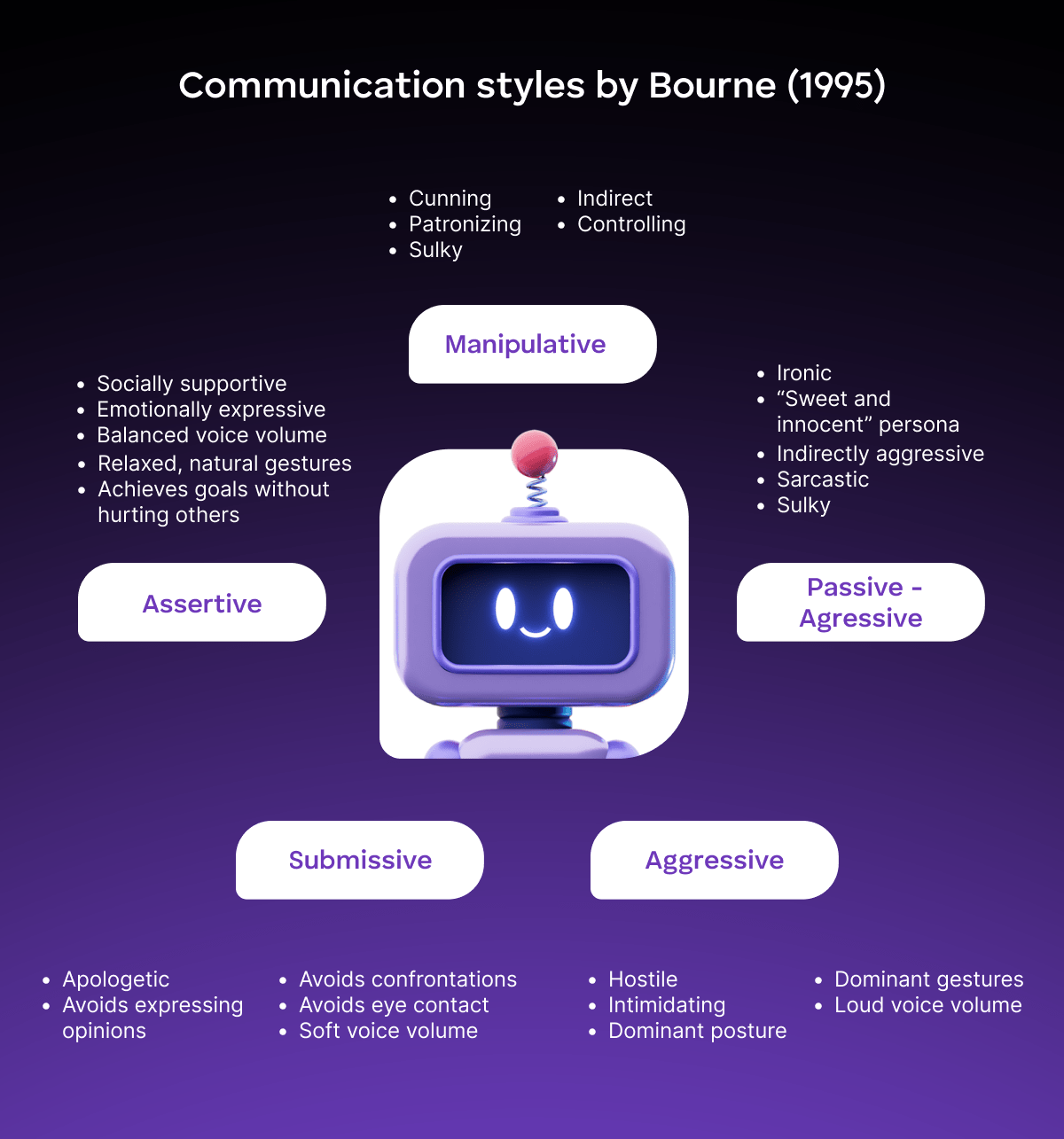
All of these styles are more than likely present in every workplace. The challenge is to balance them out and find a way for them to work together towards common goals.
In an ideal world, a workplace would be full of assertive communicators — people who respect boundaries, communicate their needs, and strive to create win-win scenarios. However, it’s much more likely that your workplace will be a mixed bag of different people.
To reconcile their communication differences in practice, you could:
- Create shorter sync meetings to get people used to each other and spot any intolerance or impatience.
- Address any issues you spot individually, rather than in a group setting.
- Organize hangout sessions or team-building activities during working hours, to improve communication and increase employee motivation.
- If possible, separate colleagues with drastically different styles of communication.
Aim to establish an acceptable level of good communication that contributes to a positive workplace environment and promotes employee well-being.
Once you’ve reached that point, you can move on to the more complex steps in your strategy to improve communication.
🎓 Pumble Pro Tip
To deepen your understanding of different styles of communication, make sure to check out different theories to find the best strategy for your individual team members:
#3 Address conflicts quickly
While implementing our previous strategy, you’ll more than likely become aware of some conflicts in your team.
By understanding different communication styles and the effects of their incompatibility, you can create applicable steps to address communication issues that stem from differences in temperaments and styles of communication.
Regardless of the source of conflicts, it’s important to acknowledge them and deal with them accordingly. This will more than enhance communication in the workplace — it will bring you one step closer to connecting your team.
Conflicts can be addressed:
- Individually,
- Only with the parties involved, or
- In a group setting, if the conflict is relevant to the entire team.
It is generally recommended to address more severe issues individually, while small misunderstandings can be addressed in a group.
A group approach can also be beneficial when it comes to strengthening a team, while an individual approach may be better for more serious subjects and problems between two people or within a group.
According to the GMAC’s Corporate Recruiters Survey, 24% of respondents mentioned conflict resolution amongst the most desirable skills in the workplace. This implies that not only are negative confrontations to be expected but that team members are also expected to be able to appropriately address them and quickly clear things up with one another.
However, depending on the seriousness of the argument, managers might be required to step in and find the root cause.
How did it come to this point? Was the issue caused by someone’s temper or style, or is it the result of a disorganized team?
Finding the cause will help resolve the issue. Moving forward, a good manager should be a role model when it comes to communication — be clear, concise, assertive and inspire others to do the same.
#4 Clarify thoughts and actions
Now that you’ve created a safe space where employee well-being is a priority and conflicts are solved as soon as they emerge, the stage is set for reorganizing your approach to assigning duties.
You don’t want a team full of confused employees. They can quickly become irritated, which leads to dissatisfaction and disengagement.
To avert this, you can analyze your workplace and your approach to task delegation by asking questions such as:
- Is everyone within your team aware of their duties?
- Are there any duty or management overlaps that can cause conflicts?
- Are all team members following protocols and processes? Is there a constructive way to help them remember all their daily obligations?
- Are all team members always on the same page?
- Does everybody get relevant information on time?
If the answers you get to these questions happen to be disheartening, don’t worry — there is a way to reorganize things to strengthen your team.
Though some of these questions can be addressed directly, others can be more difficult to manage. For example, making sure all team members remember procedures with complicated steps can be challenging and time-consuming.
To make things easier, you can set scheduled messages as reminders via a team communication app like Pumble, so various team members or teams remember important processes. Here’s what that might look like:

Improve internal organization with Pumble
#5 Schedule regular check-ins with your team
After organizing your team, you can further improve communication in the workplace by working on team bonding.
Similar to the briefly mentioned sync meetings, regular check-ins are a type of meeting that will help you create a space for your team to connect and empathize through micro-interactions.
During these simple meetings, with the right manager, team members can:
- Get a chance to share any doubts,
- Have an opportunity to look back at the previous week and feel proud of their achievements, or conclude what they could have done better,
- Share any struggles and ask for help if they require it.
During these meetings, make sure to inspire everyone to share what they’re currently working on and praise them for their weekly achievements. Show your appreciation for each team member’s contribution. Your team members will likely feel inspired to continue performing well and even improve their performance.
#6 Give, ask for, and receive feedback
Giving and receiving feedback is one of the best methods to improve communication in the workplace.
The idea behind feedback is to showcase that the same rules apply to everyone in the company. The intended result is to inspire employees to work as one and strive towards common goals.
As an employee, you should regularly ask for feedback, to further develop your performance and achieve better results. As a manager, you need to provide the incentive first and offer constructive feedback before asking for it in return.
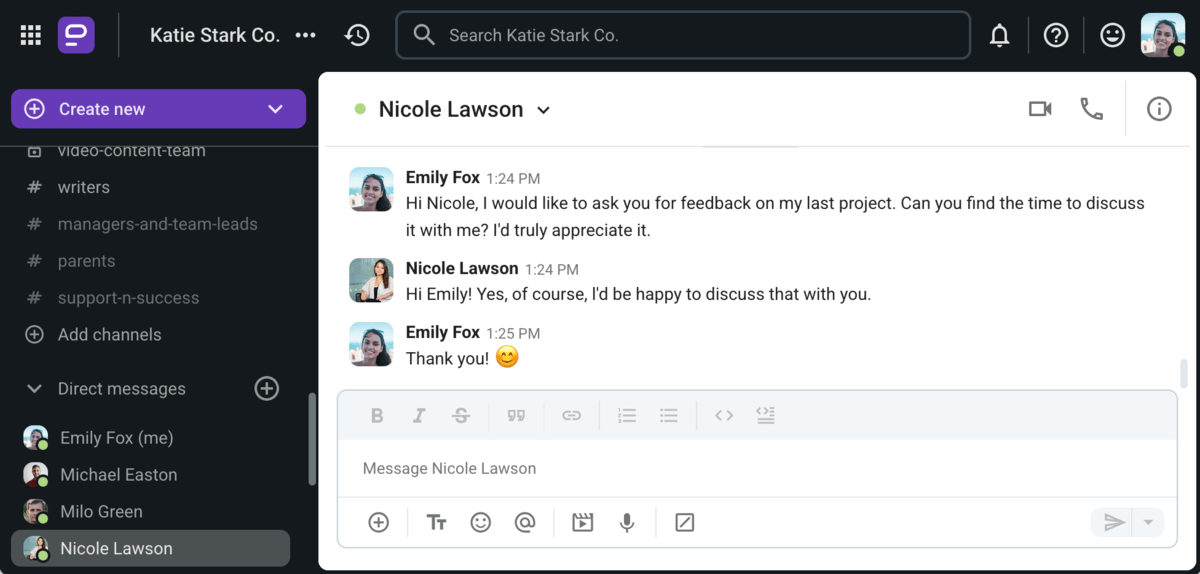
Enhance internal communication with Pumble
Here are some universal tips (for both superiors and employees) on how to ask for quality feedback, be it positive or negative:
- Ask the right people — Turn to your teammates and managers for feedback. After all, they are your closest collaborators and are in the best position to comment on your work.
- Ask yes/no questions — If you ask several people direct questions about your work, and they all reply with a “Yes” or a “No” on a particular matter, you can be certain that you’re getting honest feedback from them. For example, you can ask “Do you think I need to improve in X?”
- Ask open-ended questions — Open-ended questions require more time to answer. So, you may want to save them for your immediate superior or closest colleague. Such questions can help you get more data on a personal trait or skill you need to work on. You can ask something like, “What would you say are my weaknesses and strengths?”
- Ask at the right time — Your managers and peers may not always have the time to give you feedback, so check when they’re available.
According to Pumble’s Employee Engagement Statistics, 80% of workers who receive weekly feedback from their managers feel engaged.
Although providing it might be a daunting task, feedback is an essential part of healthy workplace communication.

🎓 Pumble Pro Tip
To learn more about giving constructive feedback, check out the following article:
If you are looking for useful performance review templates, the following resource might be useful:
#7 Create an inspiring and positive work environment
If you implement all of the aforementioned communication strategies, your workplace will be on its way to becoming a positive environment.
Workers will most likely feel like their workplace is a positive environment if they:
- Know how to communicate appropriately in the workplace,
- Know their duties and their contributions,
- Have a way to voice their concerns and are motivated to hear others out,
- Feel seen and recognized and thus motivated to improve their performance, and
- Have a manager who solves conflicts efficiently and to the benefit of everyone.
Finally, to further inspire your employees, you can also try commending your team frequently — a simple word of encouragement can go a long way.
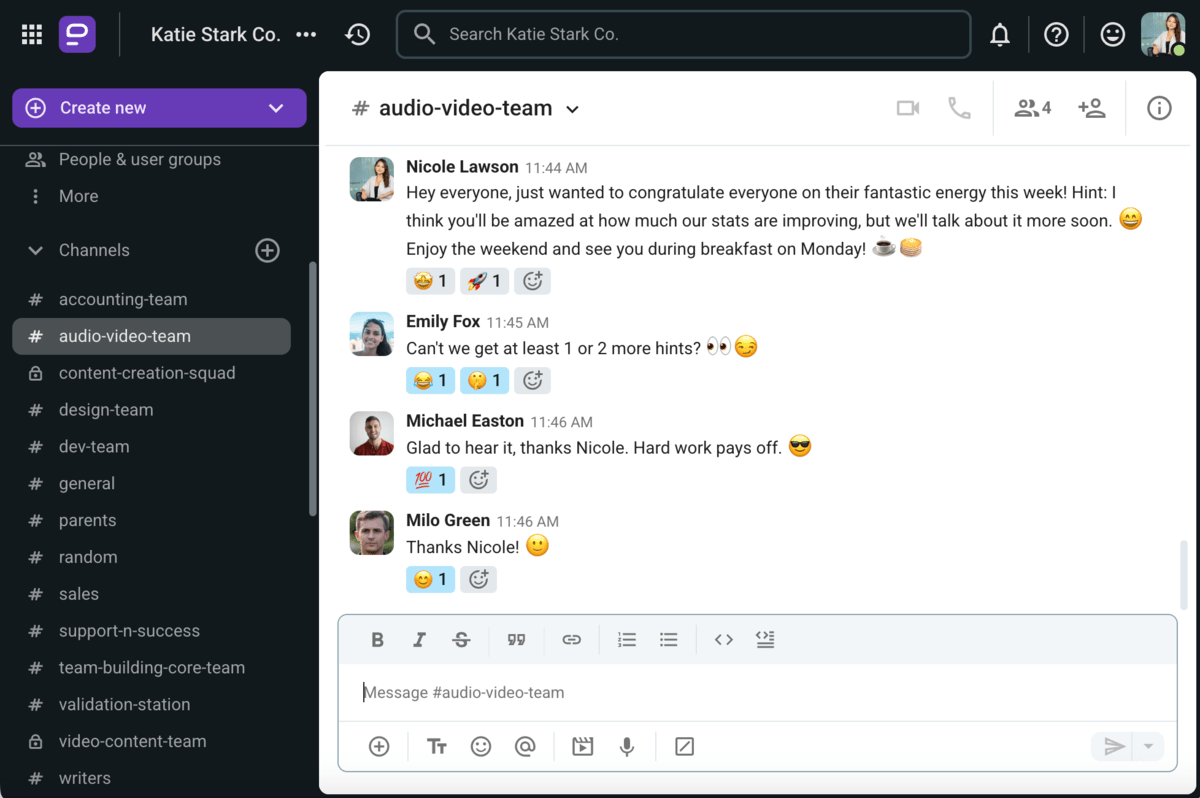
#8 Centralize your communication on a single platform
Most team communication problems can be solved by simplifying the communication process. One of the easiest ways to achieve this is through utilization of internal communication tools.
Using dedicated team communication apps can make for a smooth experience no matter the communication situation.
If you’re working on a hybrid or remote work model, these apps should be the cornerstone of your organization, as they allow for easy and effective communication within the workplace.
You can keep everyone on the same page, communicate any changes instantly to multiple team members, and schedule and reschedule processes and meetings through integrated digital calendars.
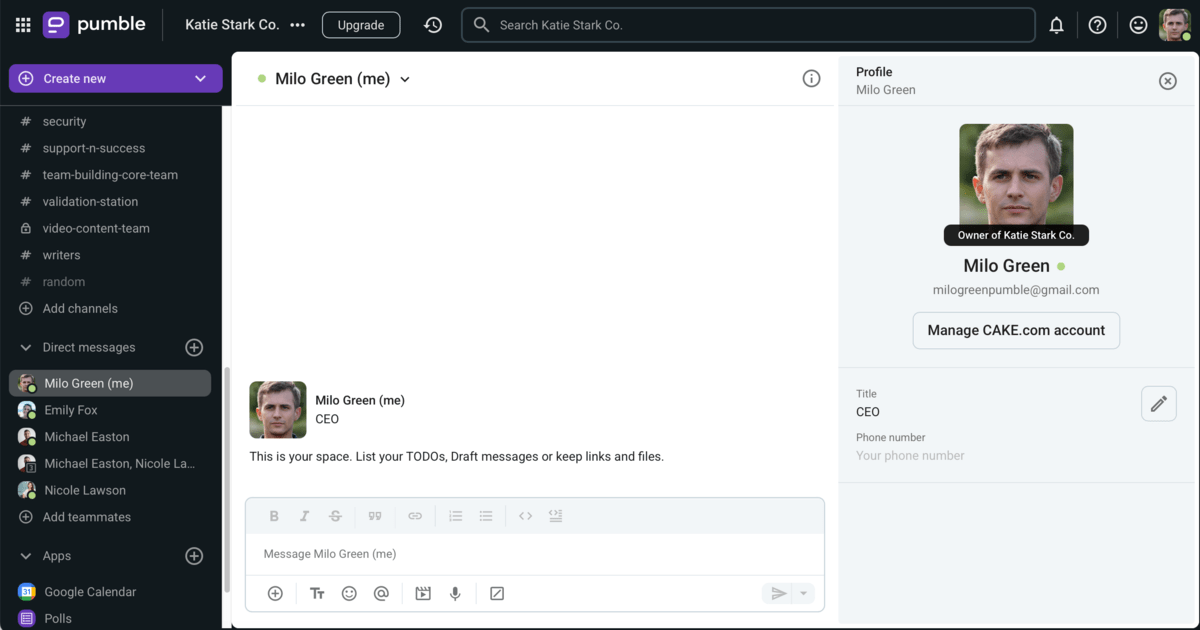
Another good thing about communication apps is that they offer you the chance to improve multiple forms of communication:
- Verbal communication (through video conferencing and audio messages) and
- Written communication (through direct messages to individuals or group messages).
The multiple options will enable your team to develop strong communication skills and get rid of some bad communication habits, which is beneficial both for internal and external communication efforts.
Improve communication with Pumble
What’s more, centralizing your communication will help you improve all types of communication within your organization:
- Upward communication, which enables team members to discuss ideas with their superiors and voice their ideas and potential concerns,
- Downward communication, used when managers or directors have to share something with employees,
- Lateral communication, applied when you ask someone from your team for information or help, and
- External communication, which involves talking to external partners or customers, depending on the nature of your job.
Remember that it’s equally important to work on all 4 types of team communication, since they foster more efficient collaboration and teamwork.
🎓 Pumble Pro Tip
To learn more about various types of communication, make sure to check out our post:
Improve communication and teamwork with Pumble
The best thing you can do to improve team communication and decrease misunderstandings is to address your employee’s pain points and lessen their stress regarding sharing information as much as possible.
By simplifying the communication process, you can set communication guidelines, clarify thoughts and actions in written form, instantly notify everyone involved, schedule regular check-ins, and make sharing important documents easy.
All of these possibilities for better and faster team communication come with Pumble, an easy-to-use team communication app.
Apart from the direct messaging, voice messaging, and video conferencing features, Pumble allows you to simplify your communication through:
- Channels — dedicated spaces for specific groups,
- Message scheduling — timed reminders for individuals, teams, and subteams,
- Guests — for including external collaborators or clients in specific channels,
- Sharing files — allowing you to keep all important documents in one place, and
- Permissions — allowing managers to control who gets access to what information, who can create channels, and edit your digital workspace when necessary.
If there is a need for some additional explanations to your team, whether in channels or direct messages, you can continue the conversation in threads.
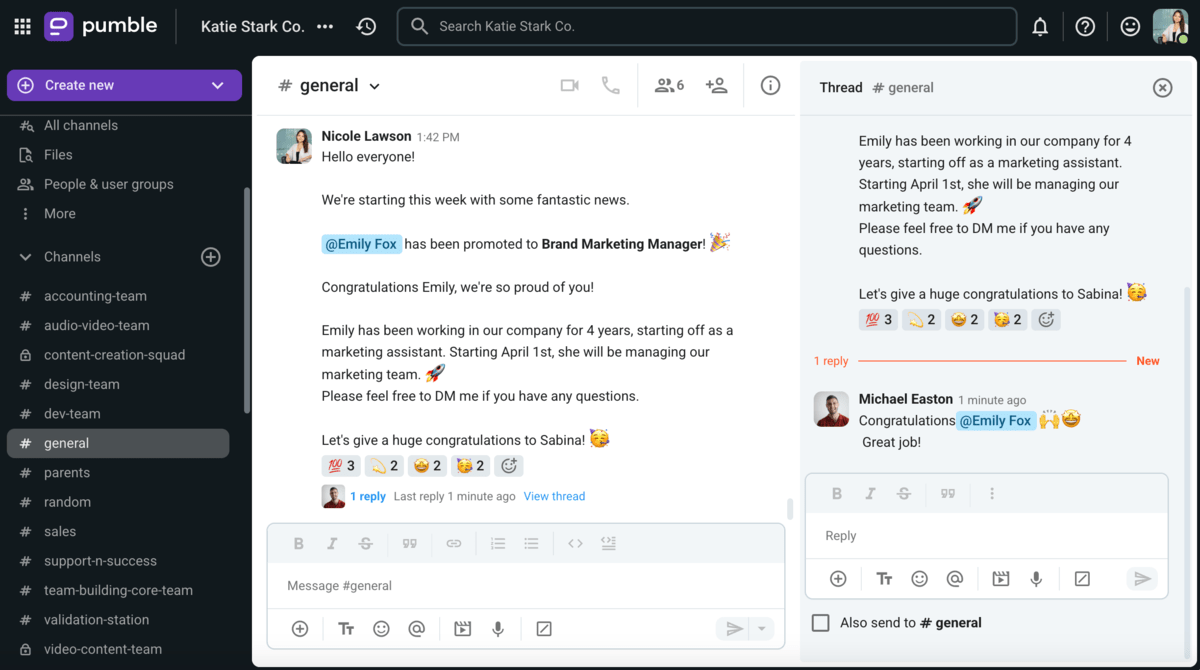
And, thanks to unlimited history, you can always get back to important messages or files you have sent before. Pumble supports files of any size, so you can simply drag and drop whatever files are necessary for your work.
Improve your communication efficiently and simplify processes for your team —
How we reviewed this post: Our writers & editors monitor the posts and update them when new information becomes available, to keep them fresh and relevant.

